Phase II Study of Docetaxel and Irinotecan in Metastatic or Recurrent Esophageal Cancer: A Preliminary Report
The outcomes for patients with metastatic or recurrent esophagealcancer are dismal, with 1-year survival rates of approximately 20%. Inthis phase II study, we studied the combination of docetaxel (Taxotere)and irinotecan (CPT-11, Camptosar) in patients with metastatic orrecurrent esophageal cancer. Eligible patients included those withhistologic or cytologic diagnosis of adenocarcinoma or squamouscancer of the esophagus or gastroesophageal junction who had receivedno previous chemotherapy for metastatic esophageal cancer. Previouschemotherapy in the neoadjuvant or adjuvant setting was allowed.Patients received irinotecan at 160 mg/m2 over 90 minutes followed bydocetaxel at 60 mg/m2 intravenously over 1 hour, with chemotherapycycles repeated every 21 days. Patients were reevaluated every twocycles. Of a planned 40 patients, 15 were enrolled, with 14 patientsevaluable for toxicity and 10 evaluable for response and survival. Thecombination of docetaxel and irinotecan resulted in a response rate of30%. An additional 40% achieved stable disease. The median survivalwas 130 days, with three patients still alive at the time of this analysis.The toxicities included 71% incidence of grade 4 hematologic toxicities,with 43% febrile neutropenia. One patient died of cecal perforationafter one cycle. There was no evidence of pharmacokinetic interaction,as systemic clearance of both drugs was similar to that seen after singleagentadministration. In conclusion, the regimen of docetaxel andirinotecan is active in metastatic or recurrent esophageal cancer.However, this combination chemotherapy regimen has an unacceptablerate of febrile neutropenia. This regimen needs to be modified toreduce the incidence of febrile neutropenia.
ABSTRACT: The outcomes for patients with metastatic or recurrent esophagealcancer are dismal, with 1-year survival rates of approximately 20%. Inthis phase II study, we studied the combination of docetaxel (Taxotere)and irinotecan (CPT-11, Camptosar) in patients with metastatic orrecurrent esophageal cancer. Eligible patients included those withhistologic or cytologic diagnosis of adenocarcinoma or squamouscancer of the esophagus or gastroesophageal junction who had receivedno previous chemotherapy for metastatic esophageal cancer. Previouschemotherapy in the neoadjuvant or adjuvant setting was allowed.Patients received irinotecan at 160 mg/m2 over 90 minutes followed bydocetaxel at 60 mg/m2 intravenously over 1 hour, with chemotherapycycles repeated every 21 days. Patients were reevaluated every twocycles. Of a planned 40 patients, 15 were enrolled, with 14 patientsevaluable for toxicity and 10 evaluable for response and survival. Thecombination of docetaxel and irinotecan resulted in a response rate of30%. An additional 40% achieved stable disease. The median survivalwas 130 days, with three patients still alive at the time of this analysis.The toxicities included 71% incidence of grade 4 hematologic toxicities,with 43% febrile neutropenia. One patient died of cecal perforationafter one cycle. There was no evidence of pharmacokinetic interaction,as systemic clearance of both drugs was similar to that seen after singleagentadministration. In conclusion, the regimen of docetaxel andirinotecan is active in metastatic or recurrent esophageal cancer.However, this combination chemotherapy regimen has an unacceptablerate of febrile neutropenia. This regimen needs to be modified toreduce the incidence of febrile neutropenia.
Although esophageal cancer accountsfor only 2% of the cancerdeaths in the United States,it is one of the leading causes of cancer-related death worldwide, with asignificantly higher incidence notedin the northern China and the trans-Kei province of South Africa.[1] Inaddition, the incidence of adenocarcinomaof the esophagus among Caucasianmen in the United States hasbeen increasing at a rate far exceedingthat of any other malignancy, includingmalignant melanoma.Nearly one-half of the patients withesophageal carcinoma present withmetastatic disease at the time of initialdiagnosis and the median survivalof such patients is about 5 to 8 months.The response rates for single-agentchemotherapy in this setting has beenapproximately 10% to 25%. The responserates for cisplatin-containing combination chemotherapy regimenshave been around 25% to 35%. Inspite of higher response rates withcombination chemotherapy, the durationof response has been very brief, lasting only 4 months.[2]There have been very encouragingreports of the use of newer chemotherapyregimens including paclitaxel,docetaxel (Taxotere), vinorelbine

(Navelbine), and irinotecan (CPT-11,Camptosar) in patients with esophagealcancer. In one of the earlier studies,Ajani et al[1] reported a 31%response rate in 51 patients with unresectableor metastatic esophagealcancer treated with single-agent paclitaxel,including one patient with acomplete response rate. In combinationwith cisplatin, paclitaxel has beenshown to have a partial response rateof 44% in patients with advanced carcinomaof the esophagus (13 of 28patients with adenocarcinoma [46%]and 1 out of 4 patients with squamouscarcinoma [25%]). Median durationof response was 3.9 months, and mediansurvival was 6.9 months.[3] Incombination with fluorouracil (5-FU)and cisplatin,[4,5] or other platinumagents,[6,7] paclitaxel produced higherresponse rates (ie, overall responserate of 48%, with median survival of10.8 months) but greater toxicity.Docetaxel appears to be more active than paclitaxel against esophagealcancer in cell culture models.[8] Therehave been only limited phase II dataon the use of docetaxel as a singleagent in patients with esophageal cancer.In a phase II study of docetaxel,Einzig et al reported that 7 out of 41(17%) patients with upper gastrointestinaltract malignancies had objectiveevidence of tumor regression, includingtwo patients with complete response.[9] The response rate in patientswith adenocarcinoma of the stomachwith docetaxel has been around 25%.In combination with cisplatin,irinotecan has been shown to have aresponse rate of 53% in patients withmetastatic or recurrent esophageal carcinoma.[10] Other irinotecan-containingregimens such as docetaxel andirinotecan appear to be non-cross-resistant.[11] In addition, phase I studydata indicate that this combinationchemotherapy regimen is feasible.Adjei et al at the Mayo Clinic conducteda phase I study in patients withadvanced solid tumors, and reportedthat the maximum tolerated dose forthe combination of irinotecan and docetaxelwas 160 mg/m2 and 65 mg/m2,respectively, administered every 21days.[12] The dose-limiting toxicitiesnoted in the study were grade 4 neutropeniaand diarrhea. Only 3 out of85 cycles of chemotherapy resulted infebrile neutropenia. Diarrhea was wellmanaged with timely use of loperamide.Five out of the 16 (31%) patientsachieved confirmed partialresponses, for a median response durationof 5 months. This combinationchemotherapy showed promising activityin patients with gastrointestinalmalignancies, even in heavily pretreatedpatients.[11,13-15]In view of the potential feasibilityof administering the combination ofdocetaxel and irinotecan, and thepromising activity of these agents inesophageal cancer, we proposed toconduct a phase II study of this combinationin patients with recurrent ormetastatic esophageal cancer whohave not received prior chemotherapyfor metastatic or recurrent esophagealcancer. In addition, we soughtto explore the role of pharmacogenomicsin predicting the toxicity andefficacy in patients with resectable esophageal cancer.Irinotecan is a prodrug, and mustbe activated by tissue carboxylesteraseto form the active metabolite SN-38that has at least 100-fold higher antitumoractivity than irinotecan. TheSN-38 formation varies approximately30-fold among patients, which maybe due to underlying genetic differencesin metabolism. Alternatively,irinotecan can be metabolized by cytochromeP450, subfamily IIIA(niphedipine oxidase), polypeptide 4(CYP3A4) to form aminopentanecarboxylicacid (APC), an inactive metabolite.SN-38 is deactivated byuridine diphosphate glucuronosyltransferases(UGTs) to form SN-38G.Differential rates of SN-38 glucuronidationhave been observed amongcancer patients and appear to be associatedwith gastrointestinal toxicity.[16]Furthermore, Zamboni et al[17] havepreviously noted that the antitumor activityof irinotecan in advanced humantumor xenografts is related to the SN-38 plasma systemic exposure.We hypothesized that the interindividualvariability in SN-38 systemicexposure might be responsible forthe variable antitumor response andtoxicity profiles among patients. Docetaxelis active against a number ofsolid tumors, and it is metabolized invivo by CYP3A4 to inactive metabolites.The disposition of docetaxel hasbeen characterized and the area underthe plasma concentration-time curve(AUC) may vary up to 10-fold in patientsreceiving the same dose andschedule of docetaxel. In several studies,AUC was a significant predictorof hematologic toxicity (grade 4 neutropeniaand febrile neutropenia) andtime to onset of fluid retention (bothP < .0001).[18,19] Furthermore, systemicexposure of docetaxel is highlycorrelated to antitumor effect in patientswith breast and non-small-celllung cancer.[19]Differences in gene expression influencethe variations in response tomany drugs. For example, a polymorphismin UGT1A1 has recently beenidentified to be associated with gastrointestinaltoxicity of irinotecan.[20]Also, a polymorphism in the CYP3A4promoter region has been shown toaffect in vitro transcription and is likely to affect drug disposition.[21-23]However, the molecular basis for variabledrug activity has not been definedfor most agents, and there aregrowing numbers of polymorphismsbeing identified in genes involved inthe disposition of these agents. Thepharmacogenetic approach to determinethe functional consequences ofgenetic polymorphism for these genesmight provide a useful tool for prospectiveprediction of toxicity and efficacyof these drugs.[22]Materials and MethodsThe primary objective of the studywas to determine the response rate forthe combination of docetaxel andirinotecan in patients with metastaticor recurrent esophageal cancer. Secondaryobjectives included the assessmentof 1-year survival, and thedetermination of the toxicities associatedwith this combination, as well asthe disposition of docetaxel, irinotecan,and the metabolites of irinotecan(SN-38, SN-38G, and APC).Eligibility criteria included patientswith histologic or cytologic evidenceof esophageal cancer with metastaticor recurrent disease. Patients shouldnot have received any prior systemicchemotherapy for metastatic or recurrentesophageal cancer. However, theycould have received one prior chemotherapyregimen in the adjuvant setting,so long as the patient had notreceived docetaxel or irinotecan priorto study entry. Patients should havecompleted radiation therapy at least 2weeks before enrollment, and havemeasurable lesions outside the irradiatedfield. Patients with metastatic diseaseto the brain were enrolledprovided they had completed brainradiation 4 weeks prior to enrollmentand have had documented stable lesions.Patients should have had anEastern Cooperative Oncology Group(ECOG) performance status of 0 or 1.Patients should have adequate bonemarrow and liver function tests. Patientswho required anticonvulsantssuch as phenytoin or carbamazepineare excluded from participating in thisstudy because of the well-known druginteraction between these agents andirinotecan.

The treatment regimen consistedof administering irinotecan at 160 mg/m2 followed by docetaxel at 60 mg/m2. Chemotherapy cycles were administeredevery 21 days. Patientsunderwent reevaluation after everytwo cycles and continued for a maximumof six cycles. We used the ResponseEvaluation Criteria In SolidTumors (RECIST) to evaluate the responses.In four patients, pharmacokineticanalysis was conducted byobtaining eight blood samples (10 mLin heparin tube) during and up to 24hours after drug administration. Docetaxelwas measured using a validatedLC/MS/MS assay (personalcommunication, S. Baker, 2003).Irinotecan and its metabolites SN-38,SN-38G, and APC were measuredusing a validated HPLC assay withfluorescence detection. A noncompartmentalmodel was used to defineAUC and systemic clearance (Win-Nonlin software). ResultsThe demographics of the patientsenrolled in the study are described in

Table 1. The majority of the patientshad adenocarcinoma (11/15), and only1 out of the 15 patients enrolled wasfemale. Of the 15 patients enrolled inthe study, 14 were evaluable for toxicityand 10 for response. The toxicityprofile is described in Table 2. Unfortunately,a significant number of patientsenrolled in the study (43%) hadneutropenic fever. One patient whohad grade 4 neutropenia died of cecalperforation thought to be related tochemotherapy. Three out of the 14patients (21%) enrolled in the studyhad grade 3 diarrhea.The response data are outlined inTable 3. Three patients had a partialresponse out of 10 evaluable patients(30%), four had stable disease, and


three have had progressive diseasewhile on therapy. The median survivalin this study was 128 days (95%confidence interval = 75-220 days)(Figure 1). A 2.3-fold and 2.8-foldrange in systemic clearance was observedfor irinotecan and docetaxel,respectively (Table 4). The AUCs fordocetaxel, irinotecan, and its metaboliteswere similar to that observed inprevious studies (Table 4).DiscussionThe combination of docetaxel andirinotecan produced a response rateof 30% in the preliminary analysis.However, a significant number of patients(43%) treated in this study hadfebrile neutropenia. While there wasonly one treatment-related death, wefeel the high incidence of febrile neutropeniais unacceptable. Interestingly,Interestingly,Couteau et al[15] recommendeddocetaxel at 75 mg/m2 and irinotecanat 250 mg/m2 for phase II studies basedon the phase I study where docetaxelwas administered first followed byirinotecan.In a phase II study of docetaxeland irinotecan in patients with advancedpancreatic cancer, Kurtz etal[24] reported a 65% incidence ofgrade 3/4 neutropenia, with 5 out of23 patients (22%) experiencing febrileneutropenia. In this study docetaxelwas administered at a dose of 60mg/m2 followed by irinotecan at 250mg/m22, every 3 weeks. Of 17 patientsevaluable for response, there were 2partial responses (12%), and 8 withstable disease. Median overall survivalwas 9.7 months for patients with nonprogressivedisease. As the measuresof both docetaxel and irinotecan dispositionwere similar to that observedin published single-agent studies,[16-19] it is unlikely that there is a pharmacokineticinteraction between thetwo agents.We would recommend studying thiscombination along with growth factorsupport or exploring weekly administrationof both the agents as they areactive in patients with adenocarcinomaof the esophagus or stomach.
Disclosures:
The author(s) have no significant financial interest or other relationship with the manufacturers of any products or providers of any service mentioned in this article.
References:
1.
Ajani JA: Treatment of patients with uppergastrointestinal carcinomas. Semin Oncol24(6 suppl 19):S19/72-S19/76, 1997.
2.
Bleiberg H, Conroy T, Paillot B, et al:Randomised phase II study of cisplatin and 5-fluorouracil (5-FU) versus cisplatin alone inadvanced squamous cell oesophageal cancer.Eur J Cancer 33(8):1216-1220, 1997.
3.
Ilson DH, Forastiere A, Arquette M, et al:A phase II trial of paclitaxel and cisplatin inpatients with advanced carcinoma of the esophagus.Cancer J 6(5):316-323, 2000.
4.
Ilson DH, Ajani J, Bhalla K, et al: Phase IItrial of paclitaxel, fluorouracil, and cisplatin inpatients with advanced carcinoma of the esophagus.J Clin Oncol 16(5):1826-1834, 1998.
5.
Petrasch S, Welt A, Reinacher A, et al:Chemotherapy with cisplatin and paclitaxel inpatients with locally advanced, recurrent or metastatic oesophageal cancer. Br J Cancer78(4):511-514, 1998.
6.
Hainsworth JD, Meluch AA, Greco FA:Paclitaxel, carboplatin, and long-term continuous5-fluorouracil infusion in the treatment ofupper aerodigestive malignancies: Preliminaryresults of phase II trial. Semin Oncol 24(6 suppl19):S19/38-S19/42, 1997.
7.
Philip PA, Zalupski MM, Gadgeel S, etal: A phase II study of carboplatin and paclitaxelin the treatment of patients with advancedesophageal and gastric cancer. Semin Oncol24(6 suppl 19):S19/86-S19/88, 1997.
8.
Kawamura H, Terashima M, Ikeda K, etal: Antitumor activities of Taxotere and Taxolagainst human esophageal cancer (abstract).Proc Am Assoc Cancer Res 38:A1540, 1997.
9.
Einzig AI, Neuberg D, Remick SC, et al:Phase II trial of docetaxel (Taxotere) in patientswith adenocarcinoma of the upper gastrointestinaltract previously untreated withcytotoxic chemotherapy: The Eastern CooperativeOncology Group (ECOG) results of protocolE1293. Med Oncol 13(2):87-93, 1996.
10.
Enzinger PC, Ilson DH, Saltz LB, et al:Irinotecan and cisplatin in upper gastrointestinalmalignancies. Oncology 12(8 suppl 6):110-113, 1998.
11.
Bissery MC, Couteau C, Oulid-Aissa D,et al: Docetaxel in combination with irinotecan:Prediction of clinical maximum tolerateddose (abstract). Proc Am Soc Clin Oncol16:A773, 1997.
12.
Adjei AA, Klein CE, Kastrissios H, et al:Phase I and pharmacokinetic study of irinotecanand docetaxel in patients with advancedsolid tumors: Preliminary evidence of clinicalactivity. J Clin Oncol 18(5):1116-1123, 2000.
13.
Takeda K, Negoro S, Masuda N, et al:Phase I/II study of docetaxel (Taxotere) andirinotecan (CPT-11) in previously untreated advancednon-small cell lung cancer (NSCLC)(abstract). Proc Am Soc Clin Oncol 16:A1742,1999.
14.
Masters GA, Haraf DJ, Hoffman PC, etal: Phase I Study of concomitant docetaxel (taxotere,TXT) and radiation (RT) in advancedchest malignancies (abstract). Proc Am Soc ClinOncol 15:A1112, 1996.
15.
Couteau C, Lokiec F, Vernillet L, et al:Phase I dose-finding and pharmacokinetic (PK)study of docetaxel (D) in combination withirinotecan (I) in advanced solid tumors (abstract).Proc Am Soc Clin Oncol 16:A709, 1997.
16.
Gupta E, Mick R, Ramirez J, et al: Pharmacokineticand pharmacodynamic evaluationof the topoisomerase inhibitor irinotecan in cancerpatients. J Clin Oncol 15(4):1502-1510, 1997.
17.
Zamboni WC, Stewart CF, Cheshire PJ,et al: Studies of the efficacy and pharmacologyof irinotecan against human colon tumor xenograftmodels. Clin Cancer Res 4(3):743-753,1998.
18.
Bruno R, Vivler N, Vergniol JC, et al: Apopulation pharmacokinetic model for docetaxel(Taxotere): Model building and validation. JPharmacokinet Biopharm 24(2):153-172, 1996.
19.
Bruno R, Hille D, Riva A, et al: Populationpharmacokinetics/pharmacodynamics ofdocetaxel in phase II studies in patients withcancer. J Clin Oncol 16(1):187-196, 1998.
20.
Ando Y, Saka H, Ando M, et al: Polymorphismsof UDP-glucuronosyltransferasegene and irinotecan toxicity: A pharmacogeneticanalysis. Cancer Res 60(24):6921-6926,2000.
21.
Sata F, Sapone A, Elizondo G, et al.CYP3A4 allelic variants with amino acid substitutionsin exons 7 and 12: Evidence for anallelic variant with altered catalytic activity.Clin Pharmacol Ther 67:48-56, 2000.
22.
Evans WE, McLeod HL. Pharmacogenomics-Drug disposition, drug targets, andside effects. N Engl J Med 348(6):538-549,2003.
23.
Lamba JK, Lin YS, Schuetz EG, et al:Genetic contribution to variable human CYP3Amediatedmetabolism. Adv Drug Deliv Rev54(10):1271-1294, 2002.
24.
Kurtz JE, Husseini F, Negrier S, et al:Docetaxel (DOC) and irinotecan (IRI) combinationchemotherapy in advanced pancreaticcancer (APC). A phase II study (abstract 2313).Proc Am Soc Clin Oncol 20:141b, 2001.
Newsletter
Stay up to date on recent advances in the multidisciplinary approach to cancer.